NCERT Book Solutions
1. A piece of wire of resistance R is cut into five equal parts. These parts are then connected in parallel. If the equivalent resistance of this combination is ‘R′, then the ratio ‘R/R′ is –
(a) 1/25
(b) 1/5
(c) 5
(d) 25
(a) 1/25
(b) 1/5
(c) 5
(d) 25
Ans. (d) 25
2. Which of the following terms does not represent electrical power in a circuit?
(a) I 2R
(b) IR2
(c) VI
(d) V 2/R
(a) I 2R
(b) IR2
(c) VI
(d) V 2/R
Ans. (b) IR2
3. An electric bulb is rated 220 V and 100 W. When it is operated on 110 V, the power consumed will be –
(a) 100 W
(b) 75 W
(c) 50 W
(d) 25 W
(a) 100 W
(b) 75 W
(c) 50 W
(d) 25 W
Ans. (d) 25W
4. Two conducting wires of the same material and of equal lengths and equal diameters are first connected in series and then parallel in a circuit across the same potential difference. The ratio of heat produced in series and parallel combinations would be –
(a) 1:2
(b) 2:1
(c) 1:4
(d) 4:1
(a) 1:2
(b) 2:1
(c) 1:4
(d) 4:1
Ans. (c) 1:4
5. How is a voltmeter connected in the circuit to measure the potential difference between two points?
Ans. To measure the potential difference between two points, a voltmeter should be connected in parallel across these points.
Concept Insight:- Voltmeter is always connected in parallel to the element of any electrical circuit across which potential difference is to be measured.
6. A copper wire has diameter 0.5 mm and resistivity of 1.6 × 10–8 Ω m. What will be the length of this wire to make its resistance 10 Ω? How much does the resistance change if the diameter is doubled?
Ans. Resistance (R) of the copper wire of length (l) and cross-section (A) is given by the expression,

where,

Resistivity of copper,

Area of cross-section of the wire,
Diameter = 0.5 mm = 0.0005 m
Resistance, R = 10 Ω
We know that,
Diameter = 0.5 mm = 0.0005 m
Resistance, R = 10 Ω
We know that,

Therefore, the length of the wire is 122.72 m.
So, if the diameter of the wire is doubled, the new diameter = 2 × 0.0005 = 0.001 m.
Let the new resistance be R'.
So, if the diameter of the wire is doubled, the new diameter = 2 × 0.0005 = 0.001 m.
Let the new resistance be R'.

Therefore, the new resistance is 2.5 Ω.
7. The values of current I flowing in a given resistor for the corresponding values of potential difference V across the resistor are given below – I (amperes) 0.5 1.0 2.0 3.0 4.0 V (volts) 1.6 3.4 6.7 10.2 13.2 Plot a graph between V and I and calculate the resistance of that resistor.
Ans. The VI graph is shown below. The voltage is plotted on x -axis and current is plotted on y -axis.
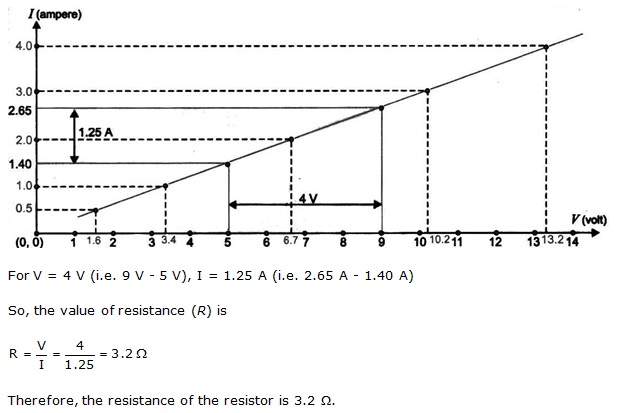
8. When a 12 V battery is connected across an unknown resistor, there is a current of 2.5 mA in the circuit. Find the value of the resistance of the resistor.
Ans. Resistance (R) of a resistor is given by Ohm's law as,
V = IR

R =
where,
Potential difference, V = 12 V
Current in the circuit, I = 2.5 mA = 2.5 x 10-3 A
9. A battery of 9 V is connected in series with resistors of 0.2 Ω, 0.3 Ω, 0.4 Ω , 0.5 Ω and 12 Ω, respectively. How much current would flow through the 12 Ω resistor?
Ans. There is no current division occurring in a series circuit. Current flow through all the components is the same, given by Ohm's law as
V = IR
where,
V = Potential difference
I = Current through the circuit
R = Resistance of the circuit
Let R be the equivalent resistance of resistances 0.2 ohm, 0.3 ohm, 0.4 ohm, 0.5 ohm and 12 ohm.
These are connected in series. Hence, the sum of the resistances will give the value of R.
R = 0.2 + 0.3 + 0.4 + 0.5 + 12 = 13.4 ohm
Potential difference, V = 9 V
Therefore, the current that would flow through the circuit and hence 12 ohm resistor is
I = V/R = 9/13.4 = 0.67 A
V = IR
where,
V = Potential difference
I = Current through the circuit
R = Resistance of the circuit
Let R be the equivalent resistance of resistances 0.2 ohm, 0.3 ohm, 0.4 ohm, 0.5 ohm and 12 ohm.
These are connected in series. Hence, the sum of the resistances will give the value of R.
R = 0.2 + 0.3 + 0.4 + 0.5 + 12 = 13.4 ohm
Potential difference, V = 9 V
Therefore, the current that would flow through the circuit and hence 12 ohm resistor is
I = V/R = 9/13.4 = 0.67 A
10. How many 176 Ω resistors (in parallel) are required to carry 5 A on a 220 V line?
Ans.
Ans.
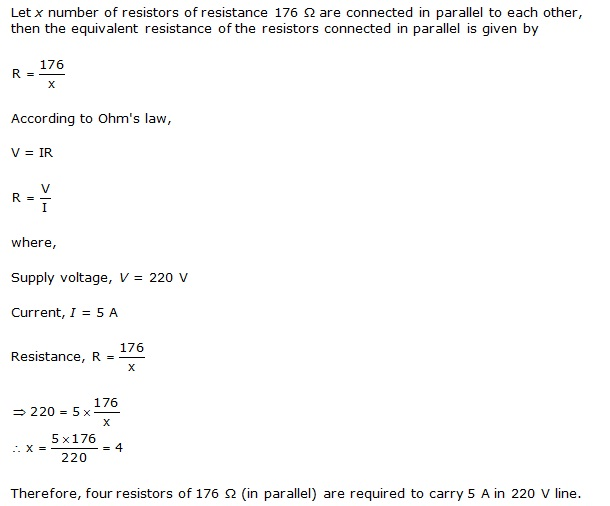
11. Show how you would connect three resistors, each of resistance 6 Ω, so that the combination has a resistance of (i) 9 Ω, (ii) 4 Ω.
Ans.
Ans.
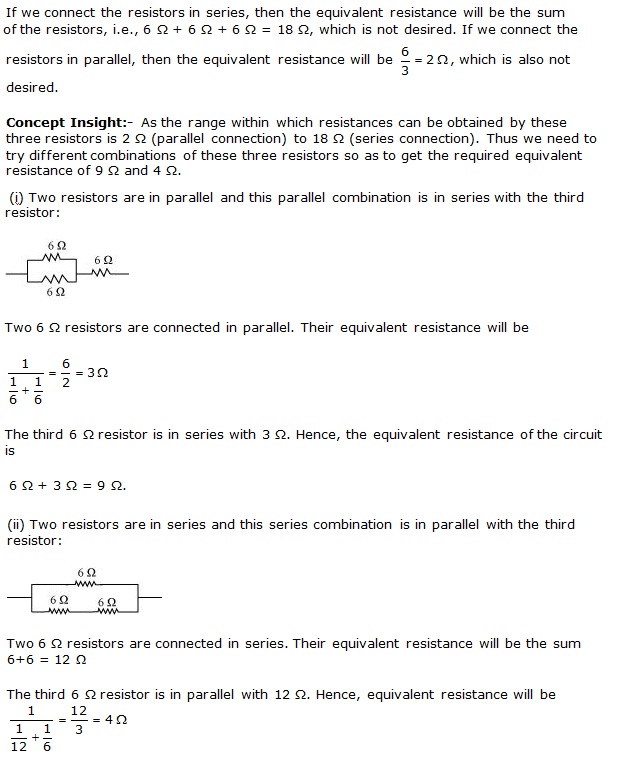
12. Several electric bulbs designed to be used on a 220 V electric supply line, are rated 10 W. How many lamps can be connected in parallel with each other across the two wires of 220 V line if the maximum allowable current is 5 A?
Ans.
Ans.
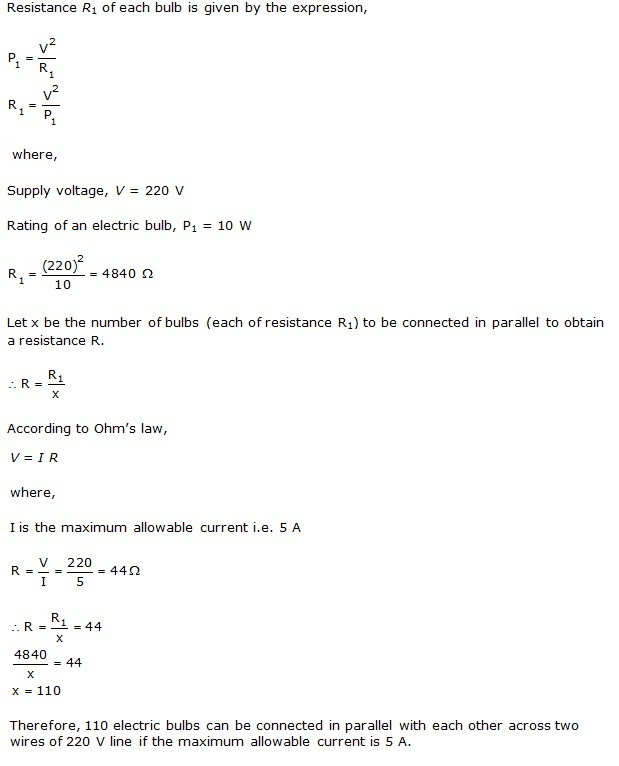
13. A hot plate of an electric oven connected to a 220 V line has two resistance coils A and B, each of 24 Ω resistances, which may be used separately, in series, or in parallel. What are the currents in the three cases?
Ans.
Ans.
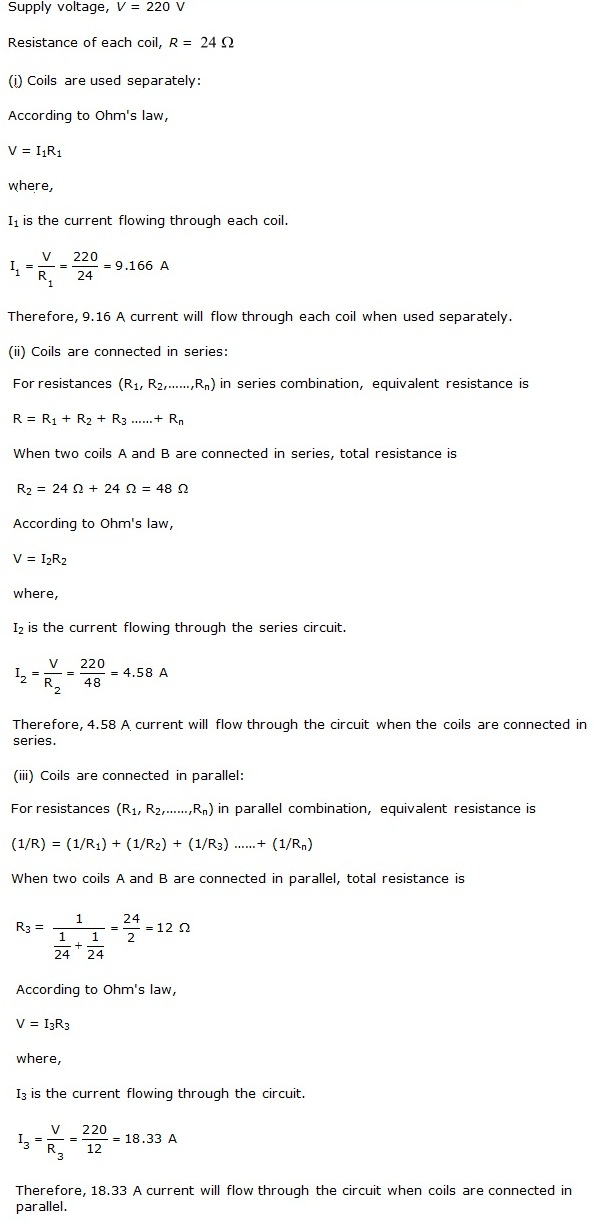
14. Compare the power used in the 2 Ω resistor in each of the following circuits:
(i) a 6 V battery in series with 1 Ω and 2 Ω resistors, and
(ii) a 4 V battery in parallel with 12 Ω and 2 Ω resistors.
Ans.
(i) a 6 V battery in series with 1 Ω and 2 Ω resistors, and
(ii) a 4 V battery in parallel with 12 Ω and 2 Ω resistors.
Ans.
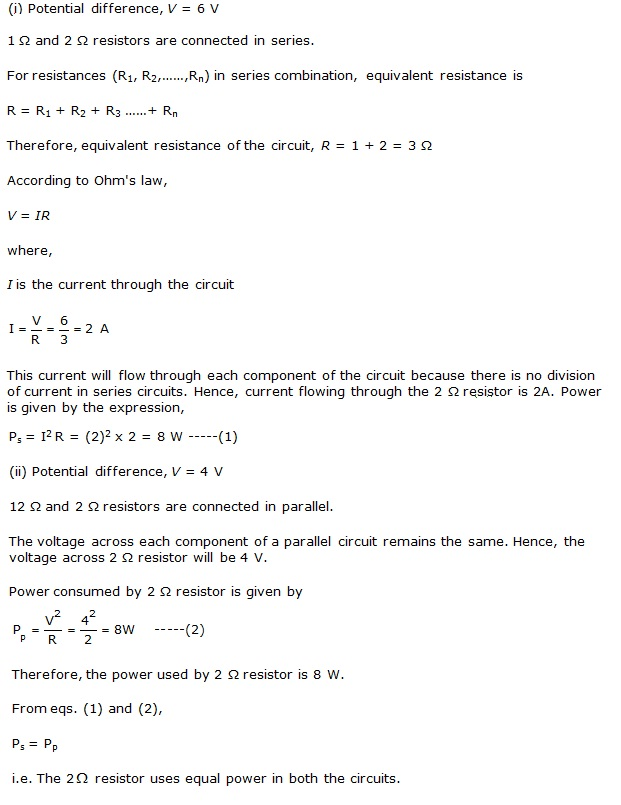
15. Two lamps, one rated 100 W at 220 V, and the other 60 W at 220 V, are connected in parallel to electric mains supply. What current is drawn from the line if the supply voltage is 220 V?
Ans. Both the bulbs are connected in parallel. Therefore, potential difference across each of them will be 220 V, because no division Of voltage occurs in a parallel circuit.
16. Which uses more energy, a 250 W TV set in 1 hr, or a 1200 W toaster in 10 minutes?
Ans. Rate of heat produced by a device is given by the expression for power as, P= I2R
Where,
Resistance of the electric heater, R= 8 Ω
Current drawn, I = 15 A
P= (15)2 x 8 = 1800 J/s
Therefore, heat is produced by the heater at the rate of 1800 J/s.
Where,
Resistance of the electric heater, R= 8 Ω
Current drawn, I = 15 A
P= (15)2 x 8 = 1800 J/s
Therefore, heat is produced by the heater at the rate of 1800 J/s.
17. An electric heater of resistance 8 Ω draws 15 A from the service mains 2 hours. Calculate the rate at which heat is developed in the heater.
Ans. Rate of heat produced by a device is given by the expression for power as, P= I2R
Where,
Resistance of the electric heater, R= 8 Ω
Current drawn, I = 15 A
P= (15)2 x 8 = 1800 J/s
Therefore, heat is produced by the heater at the rate of 1800 J/s.
Where,
Resistance of the electric heater, R= 8 Ω
Current drawn, I = 15 A
P= (15)2 x 8 = 1800 J/s
Therefore, heat is produced by the heater at the rate of 1800 J/s.
18. Explain the following.
(a) Why is the tungsten used almost exclusively for filament of electric lamps?
(b) Why are the conductors of electric heating devices, such as bread-toasters and electric irons, made of an alloy rather than a pure metal?
(c) Why is the series arrangement not used for domestic circuits?
(d) How does the resistance of a wire vary with its area of cross-section?
(e) Why are copper and aluminium wires usually employed for electricity transmission?
(a) Why is the tungsten used almost exclusively for filament of electric lamps?
(b) Why are the conductors of electric heating devices, such as bread-toasters and electric irons, made of an alloy rather than a pure metal?
(c) Why is the series arrangement not used for domestic circuits?
(d) How does the resistance of a wire vary with its area of cross-section?
(e) Why are copper and aluminium wires usually employed for electricity transmission?
Ans. (a)The melting point and resistivity of tungsten are very high. It does not burn readily at a high temperature. The electric lamps glow at very high temperatures. Hence, tungsten is mainly used as heating element of electric bulbs.
(b) The conductors of electric heating devices such as bread toasters and electric irons are made of alloy because resistivity of an alloy is more than that of metals. It produces a large amount of heat.
(c) There is voltage division in series circuits. Each component of a series circuit receives a small voltage for a large supply voltage. As a result, the amount of current decreases and the device becomes hot. Hence, series arrangement is not used in domestic circuits.
(d) Resistance (R) of a wire is inversely proportional to its area of cross-section (A), i.e.,
(b) The conductors of electric heating devices such as bread toasters and electric irons are made of alloy because resistivity of an alloy is more than that of metals. It produces a large amount of heat.
(c) There is voltage division in series circuits. Each component of a series circuit receives a small voltage for a large supply voltage. As a result, the amount of current decreases and the device becomes hot. Hence, series arrangement is not used in domestic circuits.
(d) Resistance (R) of a wire is inversely proportional to its area of cross-section (A), i.e.,
R ∝ 1A
(e) Copper and aluminium wires have low resistivity. They are good conductors of electricity. Hence, they are usually employed for electricity transmission.
Click here to visit

No comments:
Post a Comment